AMD Prepares 32-Core Naples CPUs for 1P and 2P Servers: Coming in Q2
by Ian Cutress on March 7, 2017 10:15 AM EST- Posted in
- Enterprise
- CPUs
- AMD
- SoCs
- Enterprise CPUs
- Zen
- Naples
- Ryzen
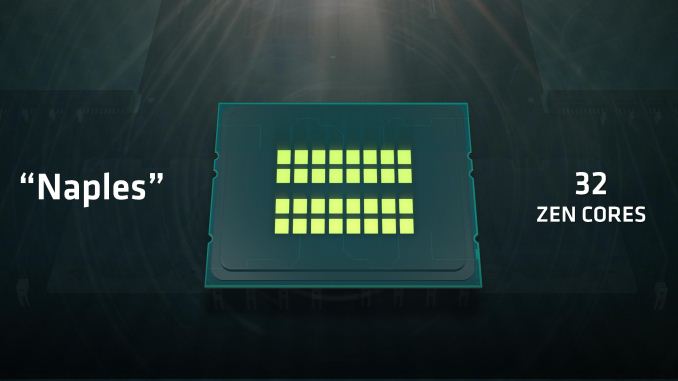
For users keeping track of AMD’s rollout of its new Zen microarchitecture, stage one was the launch of Ryzen, its new desktop-oriented product line last week. Stage three is the APU launch, focusing mainly on mobile parts. In the middle is stage two, Naples, and arguably the meatier element to AMD’s Zen story.
A lot of fuss has been made about Ryzen and Zen, with AMD’s re-launch back into high-performance x86. If you go by column inches, the consumer-focused Ryzen platform is the one most talked about and many would argue, the most important. In our interview with Dr. Lisa Su, CEO of AMD, the launch of Ryzen was a big hurdle in that journey. However, in the next sentence, Dr. Su lists Naples as another big hurdle, and if you decide to spend some time with one of the regular technology industry analysts, they will tell you that Naples is where AMD’s biggest chunk of the pie is. Enterprise is where the money is.
So while the consumer product line gets columns, the enterprise product line gets profits and high margins. Launching an enterprise product that gains even a few points of market share from the very large blue incumbent can implement billions of dollars to the bottom line, as well as provided some innovation as there are now two big players on the field. One could argue there are three players, if you consider ARM holds a few niche areas, however one of the big barriers to ARM adoption, aside from the lack of a high-performance single-core, is the transition from x86 to ARM instruction sets, requiring a rewrite of code. If AMD can rejoin and a big player in x86 enterprise, it puts a small stop on some of ARMs ambitions and aims to take a big enough chunk into Intel.
With today’s announcement, AMD is setting the scene for its upcoming Naples platform. Naples will not be the official name of the product line, and as we discussed with Dr. Su, Opteron one option being debated internally at AMD as the product name. Nonetheless, Naples builds on Ryzen, using the same core design but implementing it in a big way.
The top end Naples processor will have a total of 32 cores, with simultaneous multi-threading (SMT), to give a total of 64 threads. This will be paired with eight channels of DDR4 memory, up to two DIMMs per channel for a total of 16 DIMMs, and altogether a single CPU will support 128 PCIe 3.0 lanes. Naples also qualifies as a system-on-a-chip (SoC), with a measure of internal IO for storage, USB and other things, and thus may be offered without a chipset.
Naples will be offered as either a single processor platform (1P), or a dual processor platform (2P). In dual processor mode, and thus a system with 64 cores and 128 threads, each processor will use 64 of its PCIe lanes as a communication bus between the processors as part of AMD’s Infinity Fabric. The Infinity Fabric uses a custom protocol over these lanes, but bandwidth is designed to be on the order of PCIe. As each core uses 64 PCIe lanes to talk to the other, this allows each of the CPUs to give 64 lanes to the rest of the system, totaling 128 PCIe 3.0 again.
On the memory side, with eight channels and two DIMMs per channel, AMD is stating that they officially support up to 2TB of DRAM per socket, making 4TB in a single server. The total memory bandwidth available to a single CPU clocks in at 170 GB/s.
While not specifically mentioned in the announcement today, we do know that Naples is not a single monolithic die on the order of 500mm2 or up. Naples uses four of AMD’s Zeppelin dies (the Ryzen dies) in a single package. With each Zeppelin die coming in at 195.2mm2, if it were a monolithic die, that means a total of 780mm2 of silicon, and around 19.2 billion transistors – which is far bigger than anything Global Foundries has ever produced, let alone tried at 14nm. During our interview with Dr. Su, we postulated that multi-die packages would be the way forward on future process nodes given the difficulty of creating these large imposing dies, and the response from Dr. Su indicated that this was a prominent direction to go in.
Each die provides two memory channels, which brings us up to eight channels in total. However, each die only has 16 PCIe 3.0 lanes (24 if you want to count PCH/NVMe), meaning that some form of mux/demux, PCIe switch, or accelerated interface is being used. This could be extra silicon on package, given AMD’s approach of a single die variant of its Zen design to this point.
Note that we’ve seen multi-die packages before in previous products from both AMD and Intel. Despite both companies playing with multi-die or 2.5D technology (AMD with Fury, Intel with EMIB), we are lead to believe that these CPUs are similar to previous multi-chip designs, however there is Infinity Fabric going through them. At what bandwidth, we do not know at this point. It is also pertinent to note that there is a lot of talk going around about the strength of AMD's Infinity Fabric, as well as how threads are manipulated within a silicon die itself, having two core complexes of four cores each. This is something we are investigating on the consumer side, but will likely be very relevant on the enterprise side as well.
In the land of benchmark numbers we can’t verify (yet), AMD showed demonstrations at the recent Ryzen Tech Day. The main demonstration was a sparse matrix calculation on a 3D-dataset for seismic analysis. In this test, solving a 15-diagonal matrix of 1 billion samples took 35 seconds on an Intel machine vs 18 seconds on an AMD machine (both machines using 44 cores and DDR4-1866). When allowed to use its full 64-cores and DDR4-2400 memory, AMD shaved another four seconds off. Again, we can’t verify these results, and it’s a single data point, but a diagonal matrix solver would be a suitable representation for an enterprise workload. We were told that the clock frequencies for each chip were at stock, however AMD did say that the Naples clocks were not yet finalized.
What we don’t know are power numbers, frequencies, processor lists, pricing, partners, segmentation, and all the meaty stuff. We expect AMD to offer a strong attack on the 1P/2P server markets, which is where 99% of the enterprise is focused, particularly where high-performance virtualization is needed, or storage. How Naples migrates into the workstation space is an unknown, but I hope it does. We’re working with AMD to secure samples for Johan and me in advance of the Q2 launch.


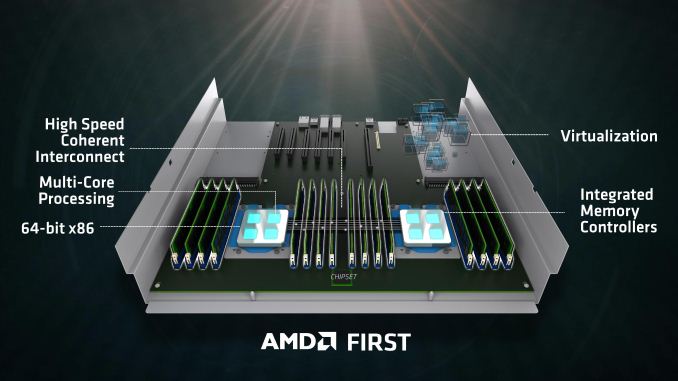
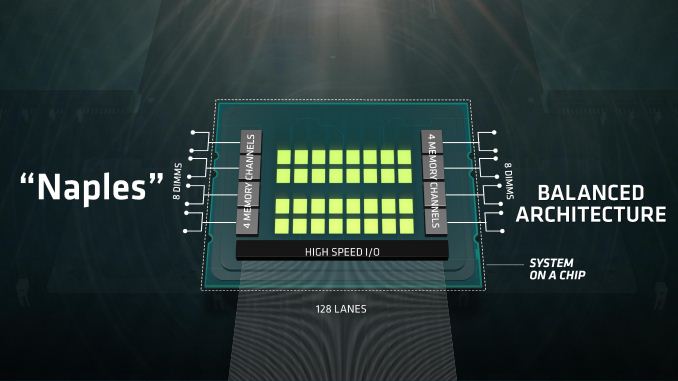
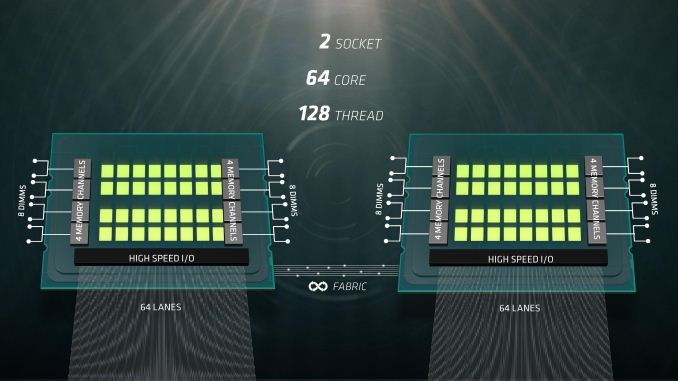
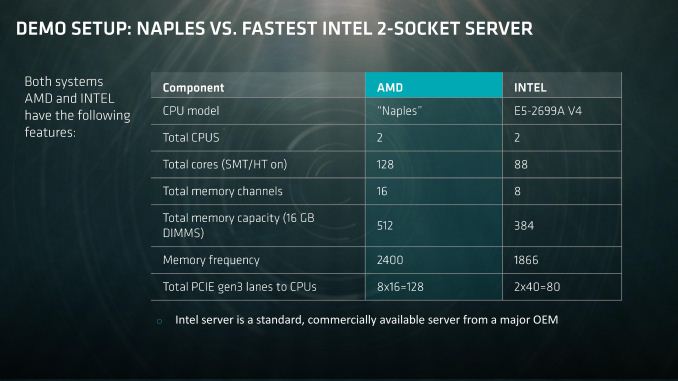
















91 Comments
View All Comments
deltaFx2 - Tuesday, March 7, 2017 - link
@Meteor2: Lower clocks: We don't know; it depends on the power. Based on what we've seen with Ryzen, idle and power under load are in fact marginally lower than Broadwell. It has lower peak clocks than kaby lake (i7700) but in server, that doesn't matter. Most of server is clocked at 2-3GHz depending on the number of cores and TDP, which Zen manages fine.IPC is a fair point, if the workload is compute-bound. If Oracle is sensitive to the ~10% IPC deficit that Zen has, it might matter. Plenty of workloads run on OSS, though: web servers/app backends being the most common case. The hard problem will be to convince folks to buy... You can't get fired for buying IBM/Intel, right :)
Icehawk - Tuesday, March 7, 2017 - link
Enterprise as you say is somewhat indifferent to pricing but what they aren't indifferent to is Intel - you would be hard pressed to get large shops to go with AMD. Intel is a known quantity and that is very important in 24/7/365 operations.deltaFx2 - Wednesday, March 8, 2017 - link
@ Icehawk: Yes, but to be fair, this isn't AMD's first rodeo. They fell off the horse and took a while to get back on. It's also not just about CPU pricing but TCO. If you want to put a lot of gpu + nvm drives on a system and need (say) 128 PCIe lanes, you need two racks of Intel 2P Xeons (or 4P xeons, if they support that many. They're even pricier). So now, add in the cost of rack, space, cooling, network switches, power, resultant bottlenecks. My point is that enterprise/cloud is not insensitive to pricing either.24/7/365: That's IBM, isn't it? The facebooks/googles/amazons won't pre-order Naples on Amazon, rest assured. They'll deploy them on small systems, study it, and scale up slowly. It will be slow and steady for AMD... My guess is server revenue will come around mid 2018.
drajitshnew - Wednesday, March 8, 2017 - link
Cast your memory back to the original opteron and p4. AMD had the lead every which way, but most data centers still preferred intel.lilmoe - Tuesday, March 7, 2017 - link
That, and higher yields for four separate smaller dies in a single package.Nem35 - Thursday, March 9, 2017 - link
Because they need their place in the market. It's better to sell 1000 CPUs for 50% of the price than 500 for 100%.More CPUs sold, better reputation, better dependability, more people satisifed = more people will purchase it in future.
QwertyTech - Tuesday, March 7, 2017 - link
Price has not been announced yet. They could undercut Intel, but the truth is we simply don't know yet the pricing.sharath.naik - Wednesday, March 8, 2017 - link
I don't think you read between the lines. Naples is 4 ryzen chips on a package. If my guess is correct it will scale better than a dual socket configuration. BUT, this is a big BUT. if each ryzen chip has 2 memory channels then does it mean the other 6 memory channels considered as remote memory?? there is a 40% drop in performance in a dual socket configuration if one socket is accessing the memory of the other. This is with intel having 4 channels (the only reason that should be the case if the memory exceeds the ram in that socket). now we are talking about just 2 channels. So my best guess is it will perform like a champ for multithreaded workload that can fit into the ram in the 2 channels(Like the vms). but would be really bad for those app that need a large amount of ram. hmm..DanNeely - Tuesday, March 7, 2017 - link
Based on the scaling numbers reported by AMD, Peter Bright at Arstechnica has concluded the benchmark AMD is showing off is extremely limited by memory bandwidth not general CPU performance.https://arstechnica.com/information-technology/201...
Krysto - Tuesday, March 7, 2017 - link
Yeah, I don't think anyone actually expects this to be twice as fast as Intel. But maybe 40%-50% should be doable, just from the extra cores alone. And likely for a lower-price as well. Either way, Naples will probably be a no-brainer for most companies.